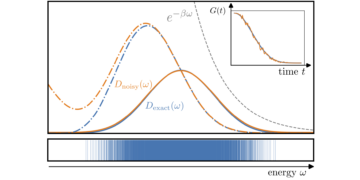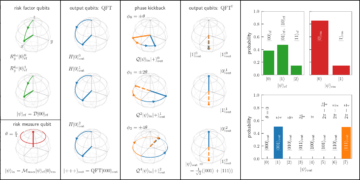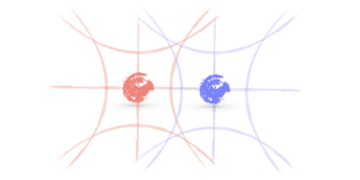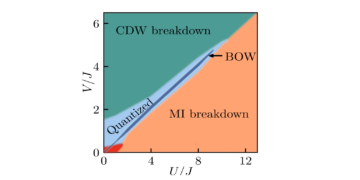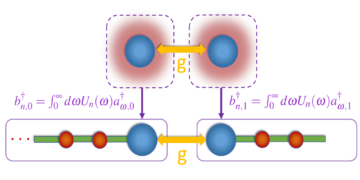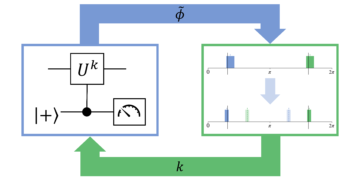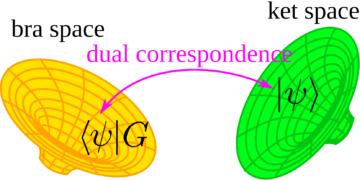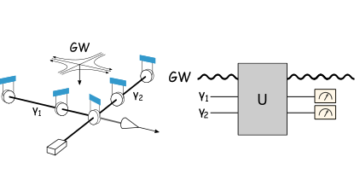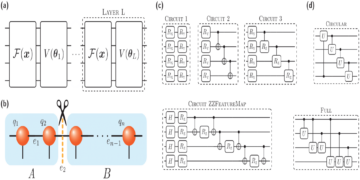1Department of Physics and Beijing Key Laboratory for Magneto-Photoelectrical Composite and Interface Science, School of Mathematics and Physics, University of Science and Technology Beijing, Beijing 100083, China
2Graduate School of China Academy of Engineering Physics, Beijing 100193, China
Find this paper interesting or want to discuss? Scite or leave a comment on SciRate.
Abstract
Computing the ground-state properties of quantum many-body systems is a promising application of near-term quantum hardware with a potential impact in many fields. The conventional algorithm quantum phase estimation uses deep circuits and requires fault-tolerant technologies. Many quantum simulation algorithms developed recently work in an inexact and variational manner to exploit shallow circuits. In this work, we combine quantum Monte Carlo with quantum computing and propose an algorithm for simulating the imaginary-time evolution and solving the ground-state problem. By sampling the real-time evolution operator with a random evolution time according to a modified Cauchy-Lorentz distribution, we can compute the expected value of an observable in imaginary-time evolution. Our algorithm approaches the exact solution given a circuit depth increasing polylogarithmically with the desired accuracy. Compared with quantum phase estimation, the Trotter step number, i.e. the circuit depth, can be thousands of times smaller to achieve the same accuracy in the ground-state energy. We verify the resilience to Trotterisation errors caused by the finite circuit depth in the numerical simulation of various models. The results show that Monte Carlo quantum simulation is promising even without a fully fault-tolerant quantum computer.
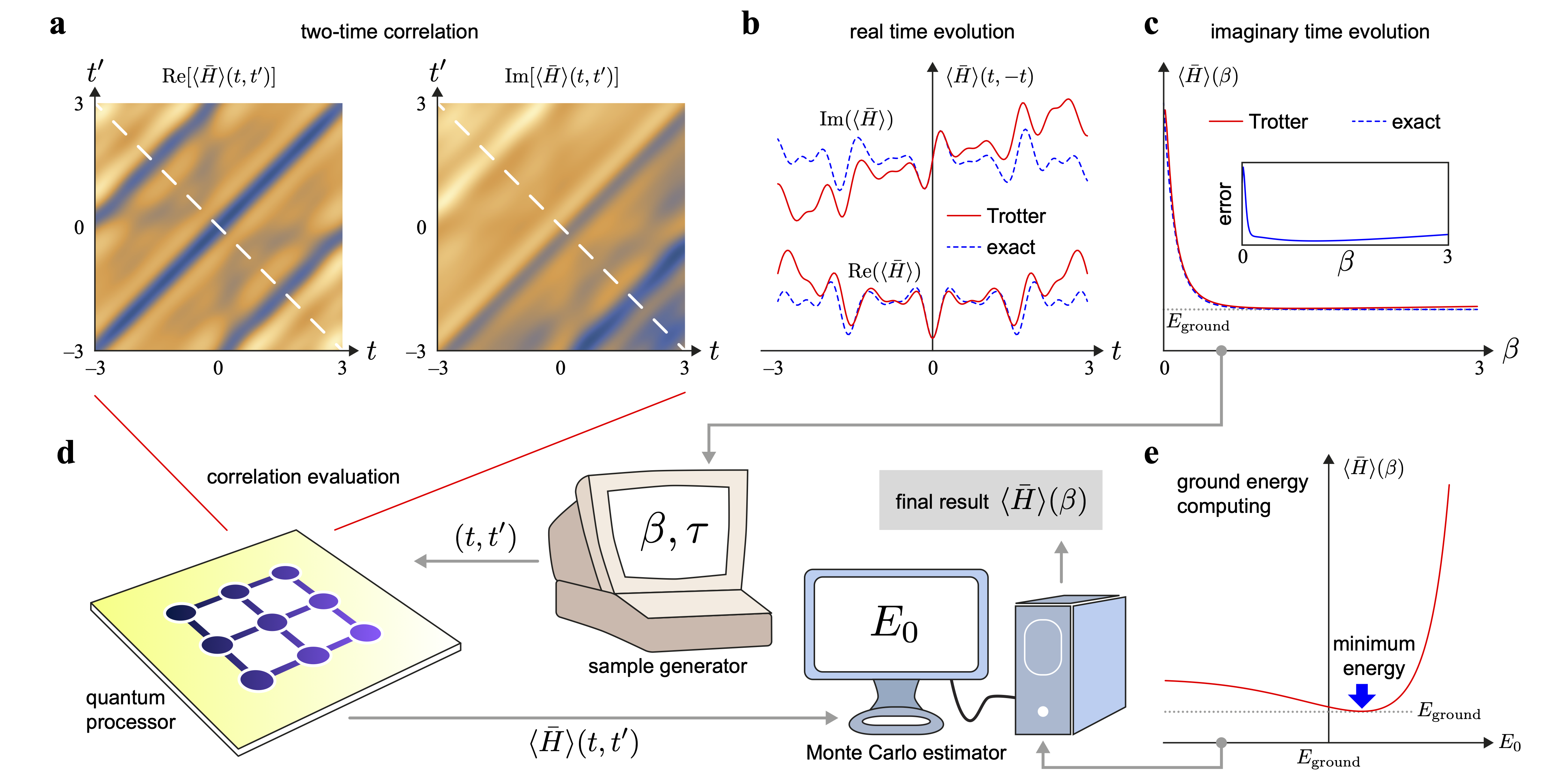
► BibTeX data
► References
[1] Richard P. Feynman. Simulating physics with computers. Internat. J. Theoret. Phys., 21 (6-7): 467–488, jun 1982. 10.1007/bf02650179.
https://doi.org/10.1007/bf02650179
[2] Seth Lloyd. Universal quantum simulators. Science, 273 (5278): 1073–1078, aug 1996. 10.1126/science.273.5278.1073.
https://doi.org/10.1126/science.273.5278.1073
[3] J. Carlson, S. Gandolfi, F. Pederiva, Steven C. Pieper, R. Schiavilla, K. E. Schmidt, and R. B. Wiringa. Quantum monte carlo methods for nuclear physics. Rev. Mod. Phys., 87 (3): 1067–1118, sep 2015. 10.1103/revmodphys.87.1067.
https://doi.org/10.1103/revmodphys.87.1067
[4] B. L. Hammond, W. A. Lester, and P. J. Reynolds. Monte Carlo Methods in Ab Initio Quantum Chemistry. WORLD SCIENTIFIC, mar 1994. 10.1142/1170.
https://doi.org/10.1142/1170
[5] W. M. C. Foulkes, L. Mitas, R. J. Needs, and G. Rajagopal. Quantum monte carlo simulations of solids. Rev. Mod. Phys., 73 (1): 33–83, jan 2001. 10.1103/revmodphys.73.33.
https://doi.org/10.1103/revmodphys.73.33
[6] U. Schollwöck. The density-matrix renormalization group. Rev. Mod. Phys., 77 (1): 259–315, apr 2005. 10.1103/revmodphys.77.259.
https://doi.org/10.1103/revmodphys.77.259
[7] Daniel S. Abrams and Seth Lloyd. Quantum algorithm providing exponential speed increase for finding eigenvalues and eigenvectors. Phys. Rev. Lett., 83 (24): 5162–5165, dec 1999. 10.1103/physrevlett.83.5162.
https://doi.org/10.1103/physrevlett.83.5162
[8] Alán Aspuru-Guzik, Anthony D. Dutoi, Peter J. Love, and Martin Head-Gordon. Simulated quantum computation of molecular energies. Science, 309 (5741): 1704–1707, sep 2005. 10.1126/science.1113479.
https://doi.org/10.1126/science.1113479
[9] Dave Wecker, Bela Bauer, Bryan K. Clark, Matthew B. Hastings, and Matthias Troyer. Gate-count estimates for performing quantum chemistry on small quantum computers. Phys. Rev. A, 90 (2): 022305, aug 2014. 10.1103/physreva.90.022305.
https://doi.org/10.1103/physreva.90.022305
[10] Markus Reiher, Nathan Wiebe, Krysta M. Svore, Dave Wecker, and Matthias Troyer. Elucidating reaction mechanisms on quantum computers. Proc. Natl. Acad. Sci., 114 (29): 7555–7560, jul 2017. 10.1073/pnas.1619152114.
https://doi.org/10.1073/pnas.1619152114
[11] Ryan Babbush, Craig Gidney, Dominic W. Berry, Nathan Wiebe, Jarrod McClean, Alexandru Paler, Austin Fowler, and Hartmut Neven. Encoding electronic spectra in quantum circuits with linear t complexity. Phys. Rev. X, 8 (4): 041015, oct 2018. 10.1103/physrevx.8.041015.
https://doi.org/10.1103/physrevx.8.041015
[12] Emanuel Knill, Raymond Laflamme, and Wojciech H. Zurek. Resilient quantum computation. Science, 279 (5349): 342–345, jan 1998. 10.1126/science.279.5349.342.
https://doi.org/10.1126/science.279.5349.342
[13] Austin G. Fowler, Matteo Mariantoni, John M. Martinis, and Andrew N. Cleland. Surface codes: Towards practical large-scale quantum computation. Phys. Rev. A, 86 (3): 032324, sep 2012. 10.1103/physreva.86.032324.
https://doi.org/10.1103/physreva.86.032324
[14] John Preskill. Quantum computing in the NISQ era and beyond. Quantum, 2: 79, aug 2018. 10.22331/q-2018-08-06-79.
https://doi.org/10.22331/q-2018-08-06-79
[15] Alberto Peruzzo, Jarrod McClean, Peter Shadbolt, Man-Hong Yung, Xiao-Qi Zhou, Peter J. Love, Alán Aspuru-Guzik, and Jeremy L. O’Brien. A variational eigenvalue solver on a photonic quantum processor. Nat. Commun., 5 (1), jul 2014. 10.1038/ncomms5213.
https://doi.org/10.1038/ncomms5213
[16] Dave Wecker, Matthew B. Hastings, and Matthias Troyer. Progress towards practical quantum variational algorithms. Phys. Rev. A, 92 (4): 042303, oct 2015. 10.1103/physreva.92.042303.
https://doi.org/10.1103/physreva.92.042303
[17] Sam McArdle, Tyson Jones, Suguru Endo, Ying Li, Simon C. Benjamin, and Xiao Yuan. Variational ansatz-based quantum simulation of imaginary time evolution. npj Quantum Inf., 5 (1), sep 2019. 10.1038/s41534-019-0187-2.
https://doi.org/10.1038/s41534-019-0187-2
[18] Mario Motta, Chong Sun, Adrian T. K. Tan, Matthew J. O’Rourke, Erika Ye, Austin J. Minnich, Fernando G. S. L. Brandão, and Garnet Kin-Lic Chan. Determining eigenstates and thermal states on a quantum computer using quantum imaginary time evolution. Nature Physics, 16 (2): 205–210, nov 2019. 10.1038/s41567-019-0704-4.
https://doi.org/10.1038/s41567-019-0704-4
[19] Sheng-Hsuan Lin, Rohit Dilip, Andrew G. Green, Adam Smith, and Frank Pollmann. Real- and imaginary-time evolution with compressed quantum circuits. PRX Quantum, 2 (1): 010342, mar 2021. 10.1103/prxquantum.2.010342.
https://doi.org/10.1103/prxquantum.2.010342
[20] William J. Huggins, Bryan A. O’Gorman, Nicholas C. Rubin, David R. Reichman, Ryan Babbush, and Joonho Lee. Unbiasing fermionic quantum monte carlo with a quantum computer. Nature, 603 (7901): 416–420, mar 2022. 10.1038/s41586-021-04351-z.
https://doi.org/10.1038/s41586-021-04351-z
[21] Andrei Alexandru, Gökçe Başar, Paulo F. Bedaque, Sohan Vartak, and Neill C. Warrington. Monte carlo study of real time dynamics on the lattice. Phys. Rev. Lett., 117 (8): 081602, aug 2016. 10.1103/physrevlett.117.081602.
https://doi.org/10.1103/physrevlett.117.081602
[22] Guifré Vidal. Efficient simulation of one-dimensional quantum many-body systems. Phys. Rev. Lett., 93 (4): 040502, jul 2004. 10.1103/physrevlett.93.040502.
https://doi.org/10.1103/physrevlett.93.040502
[23] G. C. Wick. Properties of bethe-salpeter wave functions. Phys. Rev., 96 (4): 1124–1134, nov 1954. 10.1103/physrev.96.1124.
https://doi.org/10.1103/physrev.96.1124
[24] Tong Liu, Jin-Guo Liu, and Heng Fan. Probabilistic nonunitary gate in imaginary time evolution. Quantum Inf. Process., 20 (6), jun 2021. 10.1007/s11128-021-03145-6.
https://doi.org/10.1007/s11128-021-03145-6
[25] F. Turro, A. Roggero, V. Amitrano, P. Luchi, K. A. Wendt, J. L. Dubois, S. Quaglioni, and F. Pederiva. Imaginary-time propagation on a quantum chip. Phys. Rev. A, 105 (2): 022440, feb 2022. 10.1103/physreva.105.022440.
https://doi.org/10.1103/physreva.105.022440
[26] Yongdan Yang, Bing-Nan Lu, and Ying Li. Accelerated quantum monte carlo with mitigated error on noisy quantum computer. PRX Quantum, 2 (4): 040361, dec 2021. 10.1103/prxquantum.2.040361.
https://doi.org/10.1103/prxquantum.2.040361
[27] D. F. B. ten Haaf, H. J. M. van Bemmel, J. M. J. van Leeuwen, W. van Saarloos, and D. M. Ceperley. Proof for an upper bound in fixed-node monte carlo for lattice fermions. Phys. Rev. B, 51 (19): 13039–13045, may 1995. 10.1103/physrevb.51.13039.
https://doi.org/10.1103/physrevb.51.13039
[28] Mario Motta and Shiwei Zhang. Ab initio computations of molecular systems by the auxiliary-field quantum monte carlo method. WIREs Comput. Mol. Sci., 8 (5), may 2018. 10.1002/wcms.1364.
https://doi.org/10.1002/wcms.1364
[29] Joonho Lee, Dominic W. Berry, Craig Gidney, William J. Huggins, Jarrod R. McClean, Nathan Wiebe, and Ryan Babbush. Even more efficient quantum computations of chemistry through tensor hypercontraction. PRX Quantum, 2 (3): 030305, jul 2021. 10.1103/prxquantum.2.030305.
https://doi.org/10.1103/prxquantum.2.030305
[30] Artur K. Ekert, Carolina Moura Alves, Daniel K. L. Oi, Michał Horodecki, Paweł Horodecki, and L. C. Kwek. Direct estimations of linear and nonlinear functionals of a quantum state. Phys. Rev. Lett., 88 (21): 217901, may 2002. 10.1103/physrevlett.88.217901.
https://doi.org/10.1103/physrevlett.88.217901
[31] Sirui Lu, Mari Carmen Bañuls, and J. Ignacio Cirac. Algorithms for quantum simulation at finite energies. PRX Quantum, 2 (2): 020321, may 2021. 10.1103/prxquantum.2.020321.
https://doi.org/10.1103/prxquantum.2.020321
[32] Thomas E. O’Brien, Stefano Polla, Nicholas C. Rubin, William J. Huggins, Sam McArdle, Sergio Boixo, Jarrod R. McClean, and Ryan Babbush. Error mitigation via verified phase estimation. PRX Quantum, 2 (2): 020317, may 2021. 10.1103/prxquantum.2.020317.
https://doi.org/10.1103/prxquantum.2.020317
[33] Michael A. Nielsen and Isaac L. Chuang. Quantum Computation and Quantum Information. Cambridge University Press, jun 2012. 10.1017/cbo9780511976667.
https://doi.org/10.1017/cbo9780511976667
[34] Dominic W. Berry, Graeme Ahokas, Richard Cleve, and Barry C. Sanders. Efficient quantum algorithms for simulating sparse hamiltonians. Comm. Math. Phys., 270 (2): 359–371, dec 2006. 10.1007/s00220-006-0150-x.
https://doi.org/10.1007/s00220-006-0150-x
[35] Nathan Wiebe, Dominic Berry, Peter Høyer, and Barry C Sanders. Higher order decompositions of ordered operator exponentials. J. Phys. A: Math. Theor., 43 (6): 065203, jan 2010. 10.1088/1751-8113/43/6/065203.
https://doi.org/10.1088/1751-8113/43/6/065203
[36] Andrew M. Childs and Nathan Wiebe. Hamiltonian simulation using linear combinations of unitary operations. Quantum Inf. Comput., 12 (11&12): 901–924, nov 2012. 10.26421/qic12.11-12-1.
https://doi.org/10.26421/qic12.11-12-1
[37] Dominic W. Berry, Andrew M. Childs, Richard Cleve, Robin Kothari, and Rolando D. Somma. Simulating hamiltonian dynamics with a truncated taylor series. Phys. Rev. Lett., 114 (9): 090502, mar 2015. 10.1103/physrevlett.114.090502.
https://doi.org/10.1103/physrevlett.114.090502
[38] Guang Hao Low and Isaac L. Chuang. Optimal hamiltonian simulation by quantum signal processing. Phys. Rev. Lett., 118 (1): 010501, jan 2017. 10.1103/physrevlett.118.010501.
https://doi.org/10.1103/physrevlett.118.010501
[39] Earl Campbell. Random compiler for fast hamiltonian simulation. Phys. Rev. Lett., 123 (7): 070503, aug 2019. 10.1103/physrevlett.123.070503.
https://doi.org/10.1103/physrevlett.123.070503
[40] Andrew M. Childs, Aaron Ostrander, and Yuan Su. Faster quantum simulation by randomization. Quantum, 3: 182, sep 2019. 10.22331/q-2019-09-02-182.
https://doi.org/10.22331/q-2019-09-02-182
[41] Paul K. Faehrmann, Mark Steudtner, Richard Kueng, Maria Kieferova, and Jens Eisert. Randomizing multi-product formulas for Hamiltonian simulation. Quantum, 6: 806, September 2022. ISSN 2521-327X. 10.22331/q-2022-09-19-806. URL https://doi.org/10.22331/q-2022-09-19-806.
https://doi.org/10.22331/q-2022-09-19-806
[42] Richard Meister, Simon C. Benjamin, and Earl T. Campbell. Tailoring term truncations for electronic structure calculations using a linear combination of unitaries. Quantum, 6: 637, feb 2022. 10.22331/q-2022-02-02-637.
https://doi.org/10.22331/q-2022-02-02-637
[43] Jarrod R. McClean, Mollie E. Kimchi-Schwartz, Jonathan Carter, and Wibe A. de Jong. Hybrid quantum-classical hierarchy for mitigation of decoherence and determination of excited states. Phys. Rev. A, 95 (4): 042308, apr 2017. 10.1103/physreva.95.042308.
https://doi.org/10.1103/physreva.95.042308
[44] Robert M. Parrish and Peter L. McMahon. Quantum filter diagonalization: Quantum eigendecomposition without full quantum phase estimation. September 2019. https://arxiv.org/abs/1909.08925.
arXiv:1909.08925
[45] Nicholas H. Stair, Renke Huang, and Francesco A. Evangelista. A multireference quantum krylov algorithm for strongly correlated electrons. J. Chem. Theory Comput., 16 (4): 2236–2245, feb 2020. 10.1021/acs.jctc.9b01125.
https://doi.org/10.1021/acs.jctc.9b01125
[46] Ethan N. Epperly, Lin Lin, and Yuji Nakatsukasa. A theory of quantum subspace diagonalization. SIAM Journal on Matrix Analysis and Applications, 43 (3): 1263–1290, aug 2022. 10.1137/21m145954x.
https://doi.org/10.1137/21m145954x
[47] Thomas E O’Brien, Brian Tarasinski, and Barbara M Terhal. Quantum phase estimation of multiple eigenvalues for small-scale (noisy) experiments. New J. Phys., 21 (2): 023022, feb 2019. 10.1088/1367-2630/aafb8e.
https://doi.org/10.1088/1367-2630/aafb8e
[48] Rolando D Somma. Quantum eigenvalue estimation via time series analysis. New J. Phys., 21 (12): 123025, dec 2019. 10.1088/1367-2630/ab5c60.
https://doi.org/10.1088/1367-2630/ab5c60
[49] A. Roggero. Spectral-density estimation with the gaussian integral transform. Phys. Rev. A, 102 (2): 022409, aug 2020. 10.1103/physreva.102.022409.
https://doi.org/10.1103/physreva.102.022409
[50] A. E. Russo, K. M. Rudinger, B. C. A. Morrison, and A. D. Baczewski. Evaluating energy differences on a quantum computer with robust phase estimation. Phys. Rev. Lett., 126 (21): 210501, may 2021. 10.1103/physrevlett.126.210501.
https://doi.org/10.1103/physrevlett.126.210501
[51] Kianna Wan, Mario Berta, and Earl T. Campbell. Randomized quantum algorithm for statistical phase estimation. Phys. Rev. Lett., 129 (3): 030503, jul 2022. 10.1103/physrevlett.129.030503.
https://doi.org/10.1103/physrevlett.129.030503
[52] Yuan Liu, Minsik Cho, and Brenda Rubenstein. Ab initio finite temperature auxiliary field quantum monte carlo. Journal of Chemical Theory and Computation, 14 (9): 4722–4732, aug 2018. 10.1021/acs.jctc.8b00569.
https://doi.org/10.1021/acs.jctc.8b00569
[53] Yuan-Yao He, Mingpu Qin, Hao Shi, Zhong-Yi Lu, and Shiwei Zhang. Finite-temperature auxiliary-field quantum monte carlo: Self-consistent constraint and systematic approach to low temperatures. Physical Review B, 99 (4): 045108, jan 2019. 10.1103/physrevb.99.045108.
https://doi.org/10.1103/physrevb.99.045108
[54] Tyson Jones and Simon Benjamin. QuESTlink—mathematica embiggened by a hardware-optimised quantum emulator. Quantum Sci. Technol., 5 (3): 034012, may 2020. 10.1088/2058-9565/ab8506.
https://doi.org/10.1088/2058-9565/ab8506
[55] G. Ortiz, J. E. Gubernatis, E. Knill, and R. Laflamme. Quantum algorithms for fermionic simulations. Phys. Rev. A, 64 (2): 022319, jul 2001. 10.1103/physreva.64.022319.
https://doi.org/10.1103/physreva.64.022319
[56] https://qiskit.org/documentation/nature/.
https://qiskit.org/documentation/nature/
Cited by
[1] Keisuke Matsumoto, Yuta Shingu, Suguru Endo, Shiro Kawabata, Shohei Watabe, Tetsuro Nikuni, Hideaki Hakoshima, and Yuichiro Matsuzaki, “Calculation of Gibbs partition function with imaginary time evolution on near-term quantum computers”, Japanese Journal of Applied Physics 61 4, 042002 (2022).
[2] Yu-Rong Shu, Shao-Kai Jian, and Shuai Yin, “Nonequilibrium Dynamics of Deconfined Quantum Critical Point in Imaginary Time”, Physical Review Letters 128 2, 020601 (2022).
[3] Pei Zeng, Jinzhao Sun, and Xiao Yuan, “Universal quantum algorithmic cooling on a quantum computer”, arXiv:2109.15304, (2021).
[4] Yifei Huang, Yuguo Shao, Weiluo Ren, Jinzhao Sun, and Dingshun Lv, “Efficient quantum imaginary time evolution by drifting real time evolution: an approach with low gate and measurement complexity”, arXiv:2203.11112, (2022).
[5] Yukun Zhang, Yifei Huang, Jinzhao Sun, Dingshun Lv, and Xiao Yuan, “Quantum Computing Quantum Monte Carlo”, arXiv:2206.10431, (2022).
[6] Zongkang Zhang, Anbang Wang, Xiaosi Xu, and Ying Li, “Measurement-efficient quantum Krylov subspace diagonalisation”, arXiv:2301.13353, (2023).
[7] Qingxing Xie, Yi Song, and Yan Zhao, “Power of Sine Hamiltonian Operator for Estimating the Eigenstate Energies on Quantum Computers”, arXiv:2209.14801, (2022).
The above citations are from SAO/NASA ADS (last updated successfully 2023-02-11 13:59:14). The list may be incomplete as not all publishers provide suitable and complete citation data.
On Crossref’s cited-by service no data on citing works was found (last attempt 2023-02-11 13:59:12).
This Paper is published in Quantum under the Creative Commons Attribution 4.0 International (CC BY 4.0) license. Copyright remains with the original copyright holders such as the authors or their institutions.
- SEO Powered Content & PR Distribution. Get Amplified Today.
- Platoblockchain. Web3 Metaverse Intelligence. Knowledge Amplified. Access Here.
- Source: https://quantum-journal.org/papers/q-2023-02-09-916/
- 1
- 10
- 102
- 11
- 1994
- 1996
- 1998
- 1999
- 2001
- 2012
- 2014
- 2016
- 2017
- 2018
- 2019
- 2020
- 2021
- 2022
- 2023
- 28
- 39
- 7
- 77
- 9
- a
- Aaron
- above
- ABSTRACT
- Academy
- accelerated
- access
- According
- accuracy
- Achieve
- Adam
- Adam Smith
- affiliations
- algorithm
- algorithmic
- algorithms
- All
- analysis
- and
- Anthony
- Application
- applications
- applied
- approach
- approaches
- Aug
- austin
- author
- authors
- Beijing
- Benjamin
- Beyond
- bound
- Break
- Brian
- Bryan
- cambridge
- Carlson
- caused
- chemical
- chemistry
- China
- chip
- combination
- combinations
- combine
- comm
- comment
- Commons
- compared
- complete
- complexity
- computation
- computations
- Compute
- computer
- computers
- computing
- conventional
- copyright
- Craig
- critical
- Daniel
- data
- Dave
- David
- deep
- Den
- depth
- determination
- determining
- developed
- differences
- direct
- discuss
- distribution
- dynamics
- efficient
- Electronic
- electrons
- energy
- Engineering
- Era
- Erika
- error
- Errors
- estimates
- Ether (ETH)
- evaluating
- Even
- evolution
- excited
- expected
- Exploit
- exponential
- fan
- FAST
- faster
- field
- Fields
- filter
- finding
- found
- from
- full
- fully
- function
- functions
- given
- Green
- Group
- Hardware
- harvard
- hierarchy
- higher
- holders
- HTTPS
- Hybrid
- hybrid quantum-classical
- imaginary
- Impact
- in
- Increase
- increasing
- information
- institutions
- integral
- interesting
- Interface
- International
- Jan
- JavaScript
- John
- journal
- Key
- laboratory
- large-scale
- Last
- Leave
- Lee
- License
- List
- love
- Low
- manner
- many
- Mario
- mark
- Martin
- math
- mathematics
- Matrix
- max-width
- method
- methods
- Michael
- mitigation
- models
- modified
- MOL
- molecular
- Month
- more
- more efficient
- multiple
- Nature
- needs
- New
- nuclear
- Nuclear physics
- number
- Oct
- open
- Operations
- operator
- optimal
- order
- original
- Paper
- Paul
- performing
- Peter
- phase
- physical
- Physics
- plato
- Plato Data Intelligence
- PlatoData
- Point
- potential
- power
- Practical
- press
- Problem
- PROC
- process
- processing
- Processor
- Progress
- promising
- proof
- properties
- propose
- provide
- providing
- published
- publisher
- publishers
- Quantum
- quantum algorithms
- Quantum Computer
- quantum computers
- quantum computing
- quantum information
- random
- Randomized
- reaction
- real
- real-time
- recently
- references
- remains
- ren
- requires
- resilience
- resilient
- Results
- review
- Richard
- ROBERT
- Robin
- robust
- Ryan
- Sam
- same
- sanders
- School
- SCI
- Science
- Science and Technology
- September
- Series
- shallow
- show
- siam
- Signal
- Simon
- simulation
- small
- smaller
- solution
- Solving
- speed
- State
- States
- statistical
- Step
- strongly
- structure
- Study
- Successfully
- such
- suitable
- Sun
- Surface
- Systems
- Technologies
- Technology
- ten
- The
- their
- thermal
- thousands
- Through
- time
- Time Series
- times
- Title
- to
- towards
- Transform
- under
- Universal
- university
- updated
- URL
- value
- various
- verified
- verify
- via
- volume
- W
- Wave
- without
- Work
- works
- world
- X
- year
- YING
- Yuan
- zephyrnet
- Zhao

